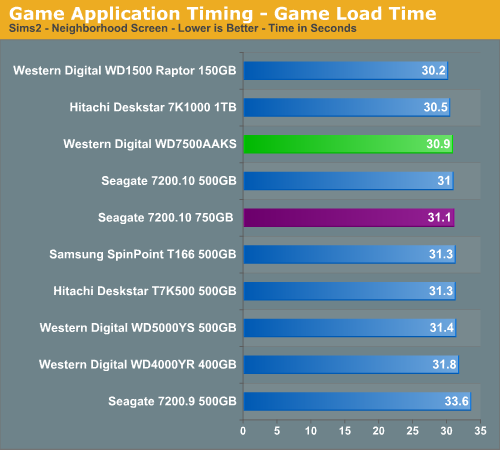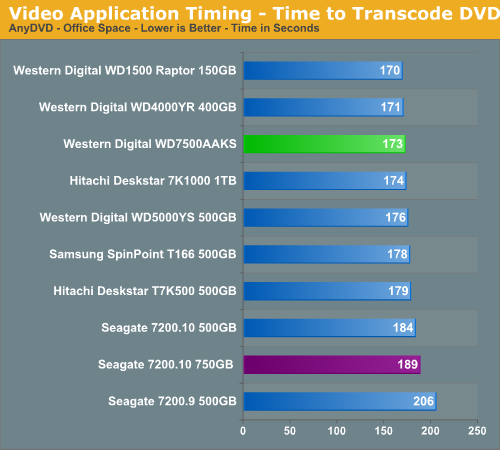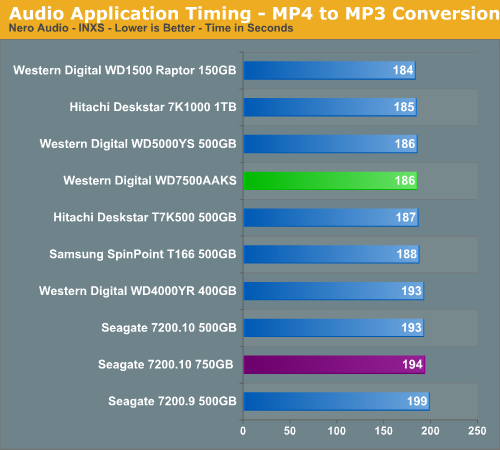Western Digital SE16 750GB: "Quiet" a Performer
by Dave Robinet on August 9, 2007 2:00 AM EST- Posted in
- Storage
Actual Application Performance
Our application benchmarks are designed to show application performance results with times being reported in seconds, lower scores thus being better. While these tests will show some differences between the drives it is important to understand we are no longer measuring the pure performance of the hard drive but how well our platform performs with each individual drive. The performance of a hard drive is an integral part of the computer platform but other factors such as memory, CPU, core logic, and even driver choice can play a major role in determining how well the hard drive performs in any given task.
Game Load Test
Our Sims 2: Open for Business test measures the time it takes to load the initial portion of the game. Our application timer starts when the game icon is initiated until the neighborhood menu appears.

In this example of a real-world test, we can see that the differential between the fastest and slowest hard drives in our benchmarks has become considerably smaller. The Raptor and Hitachi continue to place first and second respectively, though the Western Digital WD7500AAKS now turns in numbers within a fraction of a second of those drives. Of note, the Seagate 7200.10 is still bested by the WD7500AAKS, but the real-world performance levels between the two drives (like those of the other drives) are significantly closer.
Game Level Load
This test centers on the actual loading of a playable level within our game selection. The Battlefield 2 test measures the time it takes to load the Daqing Oilfields level. Our application timer begins when the start single player icon is initiated and ends when the join game icon is visible.

Continuing the real world example from above, the differential in level load times between the top performer (the Raptor) and the Western Digital WD7500AAKS is only one second (or 1.5 percent). From a price-performance standpoint, this speaks volumes, as the Raptor carries a price premium of $1.01 per GB of storage more than the WD7500AAKS. The Seagate 750GB drive is about 5% slower than our review drive in this test.
AnyDVD 6.1
Our next test has us utilizing the "ripping" function of AnyDVD to copy the Office Space DVD file from our source drive to our test drive. Our DVD features 29 files totaling 7.55GB of data and is an excellent test for determining the write speed of a drive.

Western Digital drives extend their dominance in this benchmark, taking three out of the top four slots in our chart. The WD7500AAKS comes in slightly ahead of the Hitachi 1TB drive for the first time in the real-world benchmarks, and handily trounces the Seagate 750GB drive.
Nero Audio Encode
Our last test has us utilizing the audio encoding functions of Nero to convert our INXS Greatest Hits audio files in MP4 format to a high quality variable rate MP3 file for our portable player. Our test features 16 files totaling 137MB of data and is an excellent test for determining the read and write speed of a drive.

The Hitachi 1TB manages to climb back above the Western Digital drive in this test, though the WD7500AAKS maintains its third-place position. The Seagate 750GB is once again handily defeated by the Western Digital drive, though the differential shrinks when the test shifts from a "mainly write" benchmark (as in the AnyDVD test) to a read-write combination test like this one.
Our application benchmarks are designed to show application performance results with times being reported in seconds, lower scores thus being better. While these tests will show some differences between the drives it is important to understand we are no longer measuring the pure performance of the hard drive but how well our platform performs with each individual drive. The performance of a hard drive is an integral part of the computer platform but other factors such as memory, CPU, core logic, and even driver choice can play a major role in determining how well the hard drive performs in any given task.
Game Load Test
Our Sims 2: Open for Business test measures the time it takes to load the initial portion of the game. Our application timer starts when the game icon is initiated until the neighborhood menu appears.

In this example of a real-world test, we can see that the differential between the fastest and slowest hard drives in our benchmarks has become considerably smaller. The Raptor and Hitachi continue to place first and second respectively, though the Western Digital WD7500AAKS now turns in numbers within a fraction of a second of those drives. Of note, the Seagate 7200.10 is still bested by the WD7500AAKS, but the real-world performance levels between the two drives (like those of the other drives) are significantly closer.
Game Level Load
This test centers on the actual loading of a playable level within our game selection. The Battlefield 2 test measures the time it takes to load the Daqing Oilfields level. Our application timer begins when the start single player icon is initiated and ends when the join game icon is visible.

Continuing the real world example from above, the differential in level load times between the top performer (the Raptor) and the Western Digital WD7500AAKS is only one second (or 1.5 percent). From a price-performance standpoint, this speaks volumes, as the Raptor carries a price premium of $1.01 per GB of storage more than the WD7500AAKS. The Seagate 750GB drive is about 5% slower than our review drive in this test.
AnyDVD 6.1
Our next test has us utilizing the "ripping" function of AnyDVD to copy the Office Space DVD file from our source drive to our test drive. Our DVD features 29 files totaling 7.55GB of data and is an excellent test for determining the write speed of a drive.

Western Digital drives extend their dominance in this benchmark, taking three out of the top four slots in our chart. The WD7500AAKS comes in slightly ahead of the Hitachi 1TB drive for the first time in the real-world benchmarks, and handily trounces the Seagate 750GB drive.
Nero Audio Encode
Our last test has us utilizing the audio encoding functions of Nero to convert our INXS Greatest Hits audio files in MP4 format to a high quality variable rate MP3 file for our portable player. Our test features 16 files totaling 137MB of data and is an excellent test for determining the read and write speed of a drive.

The Hitachi 1TB manages to climb back above the Western Digital drive in this test, though the WD7500AAKS maintains its third-place position. The Seagate 750GB is once again handily defeated by the Western Digital drive, though the differential shrinks when the test shifts from a "mainly write" benchmark (as in the AnyDVD test) to a read-write combination test like this one.










37 Comments
View All Comments
bigpow - Thursday, August 9, 2007 - link
signs of times..when we no longer perceived Made in China as a bad thing, I've been hearing that it's actually preferred over the recent streams of Made in Thailand electronics.
It happened to Japan & Taiwan before, now most people are happy to see those labels when they buy something.
And of course, the cool-er things in life are still Made in USA ;)
-Not that where something is produced has anything to do with the quality.
Googer - Thursday, August 9, 2007 - link
I noticed the Western Digital Raptor 150 was missing from this chart:http://images.anandtech.com/graphs/wd750_080807108...">http://images.anandtech.com/graphs/wd750_080807108...
Gary Key - Thursday, August 9, 2007 - link
I have no idea why, but after hitting our engine update button again, it is there now. :)Googer - Thursday, August 9, 2007 - link
In your benchmarking, you did not mention the size of the swapfile you have your OS set to use. I am sure it has an effect on application throughput. A static sized file is needed for benchmarking consistency.Gary Key - Thursday, August 9, 2007 - link
Our standard swapfile is fixed at 2048MB and we clean the prefetch folder after each benchmark run.imaheadcase - Thursday, August 9, 2007 - link
You can fill a WHS with 6 1TB drives for so cheap it will be great! Acoustics and heat will be a selling point for lots of people what that comes around.yyrkoon - Monday, August 13, 2007 - link
Heh, have you ever owned a 'Deathstar' ? Many, including myself will never venture down that road again.Martimus - Wednesday, August 15, 2007 - link
I have avoided IBM drives after mine died on me after only about one year. Of course Hitachi bought them out, but I don't know if they have any better longevity than they used to.strikeback03 - Tuesday, August 14, 2007 - link
An Emachines computer I bought a few years ago had a Deskstar drive. Other than the anti-static meowing noise, no problems with it for the 3 years I owned it.mostlyprudent - Thursday, August 9, 2007 - link
I am most impressed at how well the Hitachi 1TB drive continues to sit at the top of so many of the benchmarks.Your conclusion stating how well the WD drive does against the Seagate omitted the point raised in the Samsung article recently posted here. That is, Seagate's drive is almost a year older and their new 7200.11 drives are just around the corner.
Overall, it is impressive to see how tightly grouped these drive are. There seems very little reason to even consider a Raptor anymore.